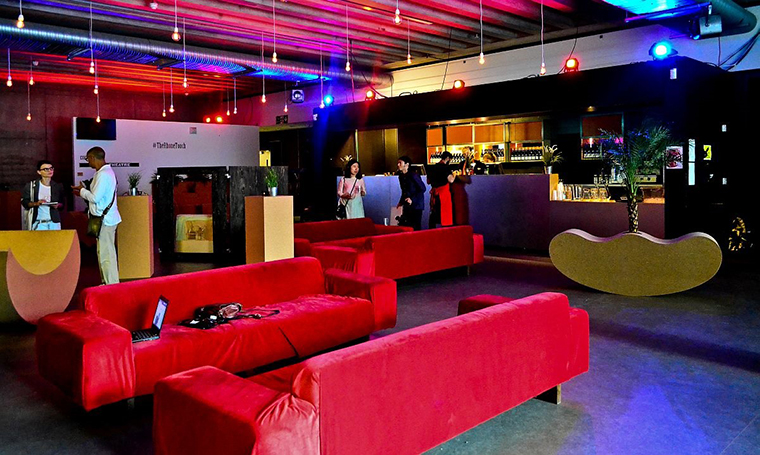Earlier this year, interactive design exhibition The Rhône Touch, showcasing work by London College of Communication students, was hosted at Central Saint Martins’ Platform Bar. Visitors could enjoy a wine tasting from the Rhône region while experiencing unique, sensorial art installations.
BA (Hons) Interaction Design Arts students developed the experimental design exhibition to combine the senses of taste, smell, sound and touch. This opportunity allowed students to curate an inventive sensory experience for Côtes du Rhône Wines and to work on a real-life professional brief.
The students’ aim was to create art installations that would enable the visitor to experience wine tasting through a more fun, accessible and dynamic approach. The exhibition was composed of 10 art installations that were designed specifically to enhance all five senses: a ‘cork popping piano’ played by Daichi Yamamoto was designed to highlight the sense of sound, the aroma Chair du Rhône was inspired by the relationship between the sense of smell and taste, and an interactive grape stomping installation was developed through the sense of touch. The guests also had an opportunity to explore a surprising wine and food matching experience at a pop-up restaurant headed by Adam Rawson, Chef of the Year at the 2015 Young British Foodies Award.
After the exhibition, we caught up with two of the students involved, Alexandra Sokolova and Rosie Allen, to hear about their experience, creative process and challenges they encountered on this project.

An Interactive Grape Stomping Installation by Tommaso Cesaro and Alexandra Sokolova. Image © Andrea Liu
Alexandra Sokolova worked in a team with fellow student Tommaso Cesaro to design the interactive grape stomping installation. The aim of the grape stomping installation was to invite the viewer to experience the traditional ways of wine making, on a sensory level. The installation was made from thousands of white ‘silicone grapes’ in two barrels and, through digital sensory lighting, the grapes would change to a red colour when treading on them to simulate the extraction of juice from the grapes.
The biggest challenge, yet also a very important lesson Alexandra learned, was producing the 3,500 silicon grapes. She explained: “After significant time spent experimenting with different materials and densities, in order to mimic the texture and consistency of grapes, we had to master the skill of time management in order to make enough grapes on time for the exhibition.” Another key highlight for Alexandra was working on a set brief with an actual client who allowed her and her fellow students to have creative freedom with the brief.
Rosie Allen was part of the team who focused on the aroma-scented chairs along with classmates Jodie Newsum and Viola Zini. Rosie gave us insight into how she and her team dismantled several armchairs to determine the perfect sensorial installation for their guests to experience the wine through the taste buds of a sommelier. Rosie elaborated: “The Rhône chairs concept was about playing with people’s senses, activating smell and touch receptors to create a customised tasting experience.”
Rosie and her team’s first prototype was a chair that they dismantled and loaded with sample scents to prove the concept could work. They found that the scents overpowered the room and they must figure out a way to activate the scents only once someone was sitting in the chair. After consulting with the team from Rhône, they also determined it would be best to select three wines from their list to represent through three armchairs.
Extensive research went into selecting the colours and smells that would best represent the wines, sourcing the perfect armchair and the ideal fabric to house the scent, and working out how to develop the mechanisms in the armchair to release scent when the viewer was sitting in the chair. Rosie and her team went through much experimentation to manage the challenges that arose in the project, but persevered, as “We hoped to create an experience for wine drinkers to relax and enjoy their wine in a fresh and fun way.”




